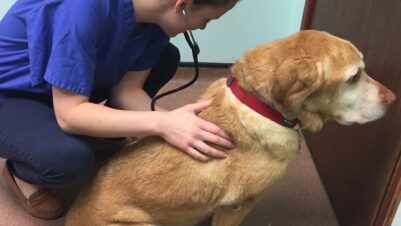FIREWORKS are now used to
celebrate all manner of events
such as birthdays, anniversaries,
religious festivals and celebrations
throughout the whole year.
Additionally, there are minimal
controls over the
use of reworks;
barring a curfew on setting off
reworks between
11pm and 7am
from private land,
and a requirement
for retailers to be
licensed to sell reworks.
So owners with sound-sensitive
pets may find it difficult to prepare
adequately for reworks events – even
if good neighbours inform them
of any planned rework displays!
However, we can help our clients
prepare for the inevitable reworks
around 5th November and the party
season by offering information and
advice.
A recent study by Bristol University
demonstrated that less than a third
of owners seek advice regarding their
dogs’ fear of loud noises and of these
only half seek assistance from their
vet (Blackwell et al, 2013). The study
found that while owners were good at
spotting the same signs that humans
display when fearful (e.g. trembling,
shaking, hiding) they were less able to
spot behavioural signs that dogs may
express such as decreased activity and
increased salivation.
How can we raise awareness amongst
our clients about sound sensitivities
and let them know about the help that
is available?
Internally, practices can produce eye-
catching waiting room displays, send
out newsletters and e-mails to clients
to remind them of the impending rework party season and use social
media to upload reminder posts. These
are all great ways of providing food
for thought for clients and providing
relevant information.
Externally, practices can look at
optimising tools that already exist.
Jon Bowen, behaviour consultant
at the Royal Veterinary College,
has developed a validated “sound
sensitivity questionnaire” (SSQ) with
his colleagues. The questionnaire can
help dog owners identify whether their dog has a sound sensitivity and provide
them with advice on the best way to
help their dog cope with reworks.
If the sound sensitivity is severe,
then a visit to the practice for
further assistance is advised. This
questionnaire can be accessed through
the Adaptil website and a link can be added to the practice website or
social media page: www.adaptil.co.uk/
Firework-Fear/Assess-your-dogs-fear-
of- reworks.
Additionally, there is footage
of Gary Landsberg, a veterinary
behaviourist at North Toronto
Behaviour Specialist Clinic, discussing
the scienti c studies and ef cacies
of both Adaptil and Feliway available
on both www.adaptil.co.uk and www.
feliway.co.uk.
What advice should we give?
An important step is to ensure the dog
has a safe haven or den to retreat to
or an area in which they feel secure.
Ideally this should be in an internal
room that is easily accessible and away from
windows.
The den can
be a place
that the dog
already uses and has been adapted to
be as comfortable, dark and quiet as
possible, or a man-made temporary
option such as a large cardboard box.
Preparing a den in advance allows
the dog to get used to the area and
accept it as a safe place to be. If using
a crate, the door should always be
left open to allow easy and instant
access/exit. Whatever format of den
is chosen, it is also advisable to use
towels and/or blankets to cover the
den area to dim the sounds and lights
of the reworks.
The use of Adaptil (a synthetic copy
of the dog-appeasing pheromone)
has been shown to reduce anxiety
and help dogs cope with challenging
situations, including rework events, as
demonstrated by Sheppard and Mills
(2003).
Please note that Adaptil reduces the
intensity of the dog’s fear response and should be used alongside other
measures to manage or treat sound
sensitivities.
Dogs pick up clues that reworks
are due well before November starts
(shortening days, falling leaves) and
their anxiety levels
may begin to elevate
in anticipation of the
event. Introducing
an Adaptil diffuser in
October can help to
combat this anxiety
build-up.
If clients visit a
practice immediately
before an expected
rework event, then advising use of
the collar, spray or tablet presentations
may be most helpful as they work
quickly. Please remember that their
ability to reduce fear responses may be
reduced if the dog is already anxious.
Further tips for
clients on the night
- Ensure dogs are taken out for a
walk/to the toilet before it gets dark to
avoid being taken out later during the reworks. - Do not fuss over or punish the dog,
as this may increase the intensity of
the emotional experience, or reward
inappropriate behaviour, but instead
consider distraction with a chew toy,
puzzle feeder or a game. - Keep curtains closed, have the TV
or radio on and keep the dog company
whilst reworks are occurring.
What about drug therapy?
Short-term use of drugs can be used
to enable a patient to
cope with
an inevitable
event, such as reworks, or as a long-term
treatment to assist in the application of
behavioural modi cation techniques
over a period of weeks and months
(Bowen and Heath, 2005).
Estelles et al (2005) found that
when using medications, owners were
less likely to implement behaviour
modi cations, so it is important to
emphasise the continued use of the
measures already described along with
medication.
The BSAVA guidelines provide
advice on the use of drug therapies:
- Diazepam (a GABA agonist)
produces short-term anxiolytic
effects and impairs the ability to
remember events that are experienced
immediately after a dose. As responses
to diazepam are highly individual, at least one trial dose
should be given at a
quiet, non-stressed
time, in order to
identify a dose effect,
speed of onset and
any adverse effects. - Alprazolam is
a triazolobenzo-
diazepine that
also has anxiolytic and anterograde amnesic effects.
Alprazolam can be used in advance of
an anticipated event, but it also impairs
the emotional memory of the event
if given afterwards (Crowell-Davies
et al, 2003). As with diazepam, a trial
dose should be administered. There is
no licensed veterinary preparation of
alprazolam.
Long term?
Getting owners to consider how
to help their dogs in the long term,
rather than opting for a quick
x each reworks season, can be
difficult. Desensitisation and counter-
conditioning have been shown to be
safe and effective methods for treating
sound sensitivities.
The Sound Scary DVD is a good
home tool to recommend for clients.
However, the dog needs to be relaxed
during this training, which means that
it needs to be done after the party reworks season has passed. Client
support throughout the process
is recommended and a referral to
a qualified behaviourist should be
considered.
Don’t forget cats!
Whilst cats are not thought to develop
sound sensitivities as dogs do, they
are still startled by reworks. Cats may
bolt when reworks go off and find
themselves a long way from home.
Ensuring clients’ cats are microchipped
can aid such cats being reunited with
their owners.
This can be prevented by keeping
cats inside after dark: some microchip-
controlled cat flaps have timers that
allow you to control access to outside
after a certain time. Once inside, there should be adequate resources provided,
including access to food, water, litter
trays and, importantly, places to hide.
A Feliway Diffuser can be used to
provide a reassuring environment in
the area they choose to spend most
time in.
References
- Blackwell, E., Bradshaw, J. and Casey
R. (2013) Fear responses to noises in
domestic dogs: Prevalence, risk factors
and co-occurrence with other fear
related behaviour. J Applied Animal
Behaviour 145: 15-25. - Bowen, J. and Heath, S. (2005) Canine
fear, anxiety and phobia-related
disorders. In: Behaviour Problems in Small
Animals, pp73-95. Elsevier.
Crowell-Davis, S. L., Seibert, L. M., - Sung, W., Parthasarathy, V. and Curtis,
T. M. (2003) Use of clomipramine,
alprazolam and behaviour modi cation
for treatment of storm phobia in dogs.
J Am Vet Med Assoc 222 (6): 744-748.
Estelles, G., Mills, D., Coleshaw, - P. H. and Shorthouse, C. (2005) A
retrospective analysis of relationships
with severity of signs of fear of reworks and treatment outcome in
99 cases. In: Current Issues and Research
in Veterinary Behavioural Medicine, ed - D Mills et al, pp161-164. Purdue
Veterinary Press, West Lafayette,
Indiana.
Sheppard, G. and Mills, D. S. (2003)
Evaluation of dog appeasing
pheromone as a potential treatment for
dogs fearful of reworks. Vet Rec 152
(4): 432-366.






